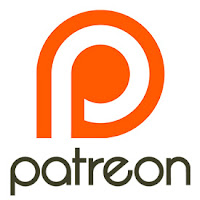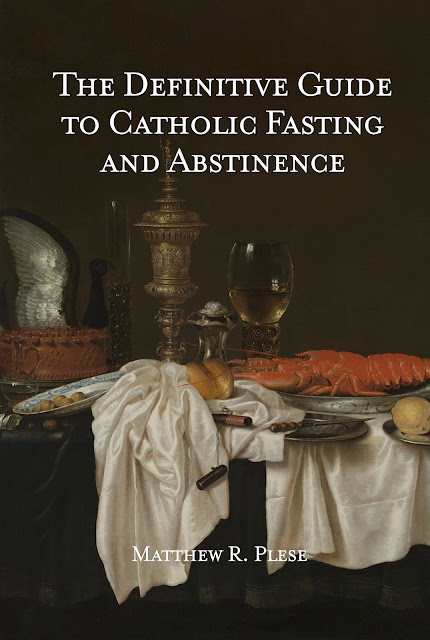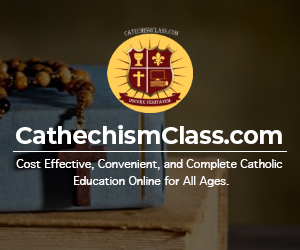Click for a larger image. Holy Saturday is not included as it is covered separately by Lenten regulations.
What are Vigils?
Even though the Great Fast of Lent has ended, our fasting has not ended. There are
many other days of fasting this year, such as Ember Days and Vigils, which are still coming this year. Understanding fasting on Vigils is something that has been forgotten by the average Catholic today. And rediscovering this practice will help us better celebrate the feastday following the vigil while
allowing us more shared days of penance.
Some feasts have vigils associated with them. The term “vigil” is used in several ways. It most properly refers to an entire day before a major feast day (e.g., the Vigil of Christmas, which refers to the entire day of December 24). This kind of vigil is a liturgical day in itself and marks the following day as a day of greater liturgical significance. This is the proper meaning of a vigil. In a similar way, the Catechism of Perseverance, published in 1849, states: “The word vigil signifies watching. The vigils are the days of abstinence and fast which precede the great festivals of the year. There are five; those of Christmas, Easter, Pentecost, Assumption, and All Saints. In some dioceses, the feast of St. Peter and St. Paul is also preceded by a vigil.”
NB: A Mass using the Sunday propers that is anticipated (i.e., offered) on a Saturday evening is sometimes, though incorrectly, called a vigil. This practice, however, is a post-Vatican II novelty and not part of Catholic Tradition, so I counsel Catholics to never attend such “vigil Masses” on Saturday evenings.
Definition of Key Terms in the Vigils Table:
Fasting: Fasting refers to how much food we eat. It means taking only one meal during a calendar day. The meal should be an average-sized meal as overeating at the one meal is against the spirit of the fast. Fasting generally means that the meal is to be taken later in the day. Along with the one meal, up to two snacks (technically called either a collation or frustulum) are permitted. These are optional, not required. Added up together, they may not equal the size of the one meal. No other snacking throughout the day is permitted. Fasting does not affect liquids, aside from the Eucharistic Fast which is a separate matter.
Abstinence: Abstinence in this context refers to not eating meat. Meat refers to the flesh meat of mammals or fowl. Beef, poultry, lamb, etc. are all forbidden on days of abstinence. Abstinence does not currently prohibit animal byproducts like dairy (e.g., cheese, butter, milk) or eggs, but in times past, they were prohibited. Fish is permitted along with shellfish and other cold-blooded animals like alligators. In times past, days of fasting were always days of abstinence as well; however, not all days of abstinence were days of mandatory fasting.
Partial Abstinence: Partial Abstinence refers to eating meat only at the principal meal of the day. Days of partial abstinence do not permit meat to be eaten as part of the collation or the frustulum. Partial abstinence started only in 1741 under Pope Benedict XIV as a concession and as part of a gradual weakening of discipline. Beforehand, days of abstinence were days of complete abstinence.
NB: The table concerns only fasting and abstinence for Vigils and thus omits other possible days of fasting and/or abstinence: Lent, Ember Days, Rogation Days, etc.
Explanation of Key Changes to Vigils in the English-Speaking World:
1. On March 9, 1777, Pope Pius VI reduced for English Catholics days of fasting to consist of the Ember Days; the forty days Lent; Wednesdays and Fridays in Advent; and the vigils of Christmas, Whitsun Sunday (i.e. Pentecost), Ss. Peter and Paul, and All Saints.
2. As mentioned in the Irish Ecclesiastical Record from 1882, Pope Benedict XIV in 1755 removed 18 feasts from double precept and reduced them to single precept. Shortly thereafter in 1778, Pope Pius VI reduced the number of holy days to 13. And as the Record states, "On this occasion, the obligation of hearing Mass was removed, as well as the obligation of abstaining from servile works." The Record continues: "the number of those Vigils to which the obligation of fasting had been attached [as of 1778] was in fact but eight - these being the Vigils of the feast of St. Laurence the Martyr (August 9th), and of seven of the nine suppressed feasts of the Apostles." No fasting was observed beforehand on the Vigil of St. John on December 26 or the Vigil of Ss. Philip and James on account of them always falling in Christmas and Pascaltide respectively.
3. The Vigil of Ss. Peter and Paul ceased being a fast day in America by 1842. In Great Britain, Ireland, Australia, and Canada the Vigil of Ss. Peter and Paul remained a day of fasting and abstinence up until the 1917 Code of Canon law. In 1902, the Holy Father granted a special dispensation for Catholics in England from fasting on the Vigil of Ss. Peter and Paul in honor of the coronation of King Edward VII, illustrating historical proof of its observance in the early part of the 20th century.
4. "The Catholic's Pocket Prayer-Book" published by Henri Proost & Co in 1924 notes "in the United Kingdom (except during Lent), abstinence is not binding on Ember Saturdays or on any Vigil that immediately precedes or follows a Friday or other day of abstinence."
5. Effective with the 1917 Code, fasting and abstinence were no longer observed should a vigil fall on a Sunday as stated in the code: "If a vigil that is a fast day falls on a Sunday the fast is not to be anticipated on Saturday but is dropped altogether that year." Before 1917, the fast of a Vigil that fell on a Sunday was observed instead on the preceding Saturday.
6. On January 28, 1949, the United States bishops issued modified regulations on abstinence in America again after receiving a ruling from the Sacred Congregation of the Council. Partial abstinence replaced complete abstinence for Ember Wednesdays, Ember Saturdays, and the Vigil of Pentecost.
7. In March 1955, Pope Pius XII abolished the liturgical Vigil of All Saints. The US Bishops requested an official determination from Rome on whether the custom of fasting and abstinence on the suspended Vigil of All Saints had also been terminated. They received a pre-printed notice in a response dated March 15, 1957, stating: "The Decree of the Sacred Congregation of Rites...looks simply to the liturgical part of the day and does not touch the obligation of fast and abstinence that are a penitential preparation for the following feast day." The US Bishop thereafter dispensed both the fast and partial abstinence law for the Vigil of All Saints.
8. On July 25, 1957, Pope Pius XII commuted the fast in the Universal Church from the Vigil of the Assumption to the Vigil of the Immaculate Conception on December 7, even though he had previously abrogated the Mass for the Vigil of the Immaculate Conception.
9. In 1959, Pope John XXIII permitted the Christmas Eve fast and abstinence to be transferred to 23rd. While the United States, Great Britain, and Ireland kept the penance on December 24, other nations, including Canada and the Philippines, transferred it to December 23.
10. As stated in a January 1960 issue of the Catholic Standard and Times, following an October 1959 meeting, the Bishops of Canada issued new regulations taking effect in 1960 that provided that the law of abstinence henceforth will apply only on all Fridays of the year, while the regulations for fast and abstinence will apply only on four days—Ash Wednesday; Good Friday; December 7, the vigil of the feast of the Immaculate Conception, and December 23, the anticipated vigil before Christmas.
How are Vigils Observed?
There are two characteristics of vigils: penance and prayer.
As to penance, many liturgical vigils, if not all, were originally also days of fasting and abstinence. Over time, the fasting and abstinence was dropped from many. By the time of the Catechism of Perseverance, there were only a few such vigils. But the days of fasting and abstinence differed – including on vigils in various places. For instance,
by 1893, the only fasting days kept in Rome were the forty days of Lent, the Ember Days, and the Vigils of the Purification, of Pentecost, of St. John the Baptist, of Ss. Peter and Paul, of the Assumption, of All Saints, and of Christmas. This is summarized from the Handbook to Christian and Ecclesiastical Rome. In just a few years, Rome would abrogate the fast on the Vigil of the Purification and on the Vigil of St. John the Baptist. By the 1917 Code of Canon Law, fasting vigils were dropped universally to only four days: Vigils of Pentecost, the Assumption of the Blessed Virgin Mary, All Saints, and Christmas. These are what Americans at that time were aware of, but previously, there were differing vigils.
By 1917, there were, however, still many other liturgical vigils on the calendar that were not obligatory days of abstinence at that time. For instance, before the changes to the Roman Rite liturgical calendar in 1955, nearly all feasts of the Apostles were preceded by a vigil. And the Church put those days in place to help us prepare for the importance of the feast of an Apostle,
since all feasts of the Apostles were in former times Holy Days of Obligation. We have lost the importance of the feast days of the Apostles, I believe, in part due to losing the vigils. We can change that for ourselves by observing those feast days in our own prayer lives. And the same is true for the Vigil of All Saints (i.e., Halloween), a traditional day when we would fast and abstain from meat, but which is neither found in the Novus Ordo calendar nor even in the 1962 Missal. Hence any of the older vigils (e.g., the Vigil of St. Lawrence, the Vigil of Epiphany, the Vigil of the Nativity of St. John the Baptist, etc.) can and arguably, should, be observed with fasting and abstinence even if they are not obliged under penalty of sin.
The second key feature of vigils is prayer.
The Catechism of Perseverance explains this aspect well: “How should we spend the vigils? Whatever be our age, we should spend those days in a more holy manner than other days, in order to prepare for the celebration of the festival and to receive the graces which God always gives more abundantly at that time.” Praying an extra rosary, making time for mental prayer, and even praying into the evening as the vigil becomes the feastday itself are all worthwhile practices to make vigils slightly more penitential and all the more prayerful.
While we know that Sundays and Holy Days of Obligation should be spent in prayer, attendance at Holy Mass, and in avoidance of servile work, we often pay little mind to vigils since the Church over the past several decades has virtually eliminated them. But we must honor our Lady of Fatima’s call for penance and can model our example after that of our forefathers who observed the vigils in preparation for the feast.
Works Cited:
1. Great Britain (1776): American Ecclesiastical Review (Hardy and Mahony, 1886), vol. 11, p. 469.https://www.google.com/books/edition/The_American_Catholic_Quarterly_Review/lz0QAAAAYAAJ
2. USA (1789): American Ecclesiastical Review (Hardy and Mahony, 1886), vol. 11, p. 469.https://www.google.com/books/edition/The_American_Catholic_Quarterly_Review/lz0QAAAAYAAJ
3. USA (1909): O'Neill, J.D. (1909). Fast. In The Catholic Encyclopedia. New York: Robert Appleton Company. http://www.newadvent.org/cathen/05789c.htm
4. Great Britain (1909): O'Neill, J.D. (1909). Fast. In The Catholic Encyclopedia. New York: Robert Appleton Company. http://www.newadvent.org/cathen/05789c.htm
5. Canada (1909): O'Neill, J.D. (1909). Fast. In The Catholic Encyclopedia. New York: Robert Appleton Company. http://www.newadvent.org/cathen/05789c.htm
6. CIC (1917): Peters, Edward N. 1917 Pio-Benedictine Code of Canon Law: in English translation, with extensive scholarly apparatus. San Francisco: Ignatius Press, 2001. https://www.jgray.org/codes/
7. Canada (1952): https://sspx.ca/en/rules-fast-abstinence
8. USA (1962): Rev. Heribert Jone, “Moral Theology: Englished and Adapted to the Laws and Customs of the United States of America,” (Newman Press, 2009), p. 285.
9. Canada (1962): The Catholic Standard and Times, Volume 65, Number 19, Published January 29, 1960. https://thecatholicnewsarchive.org/?a=d&d=cst19600129-01.2.77&e=-------en-20--1--txt-txIN--------
10. Great Britain (1962): 1962 Roman Catholic Daily Missal, (Angelus Press, 2004).














.jpg)












